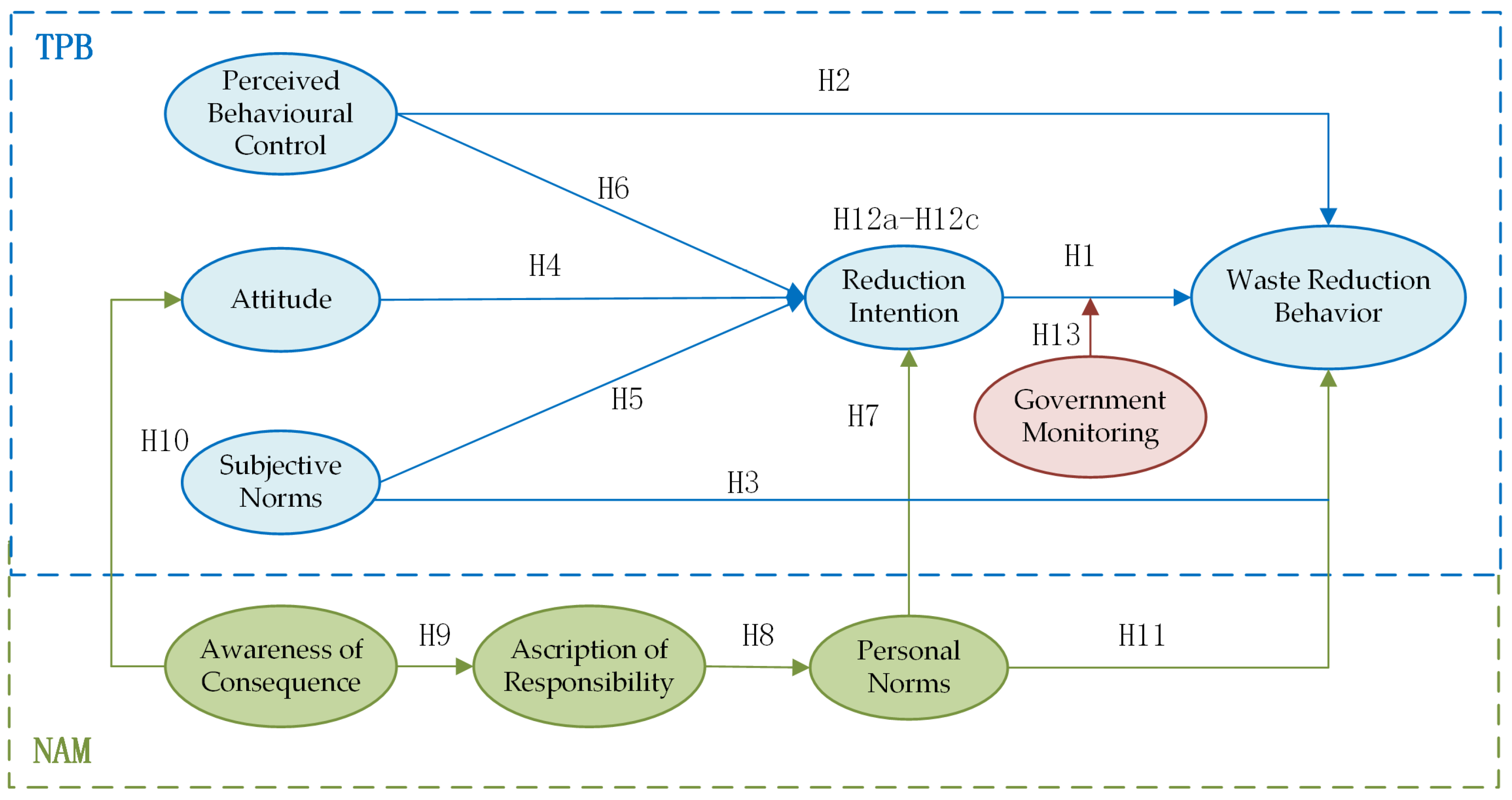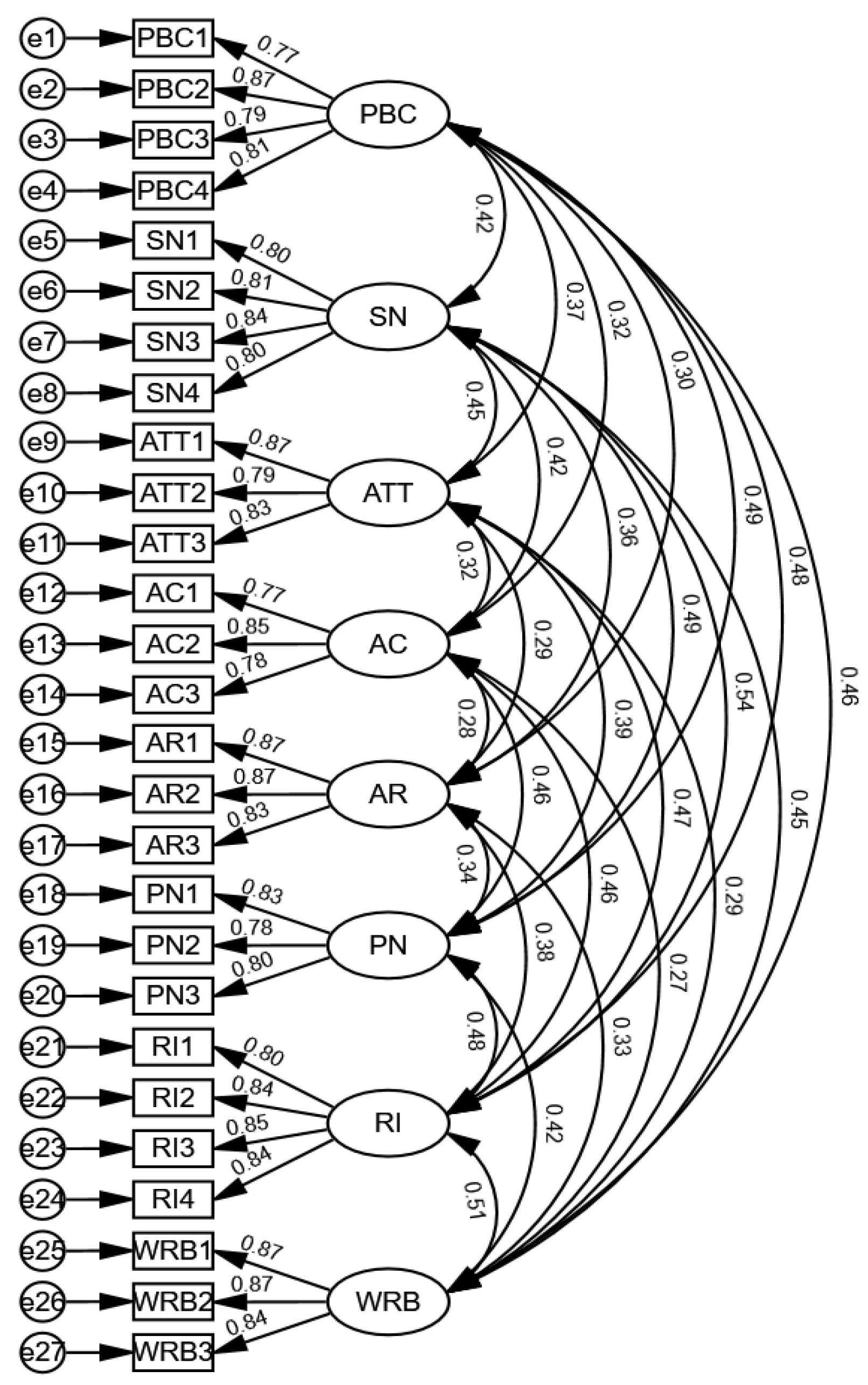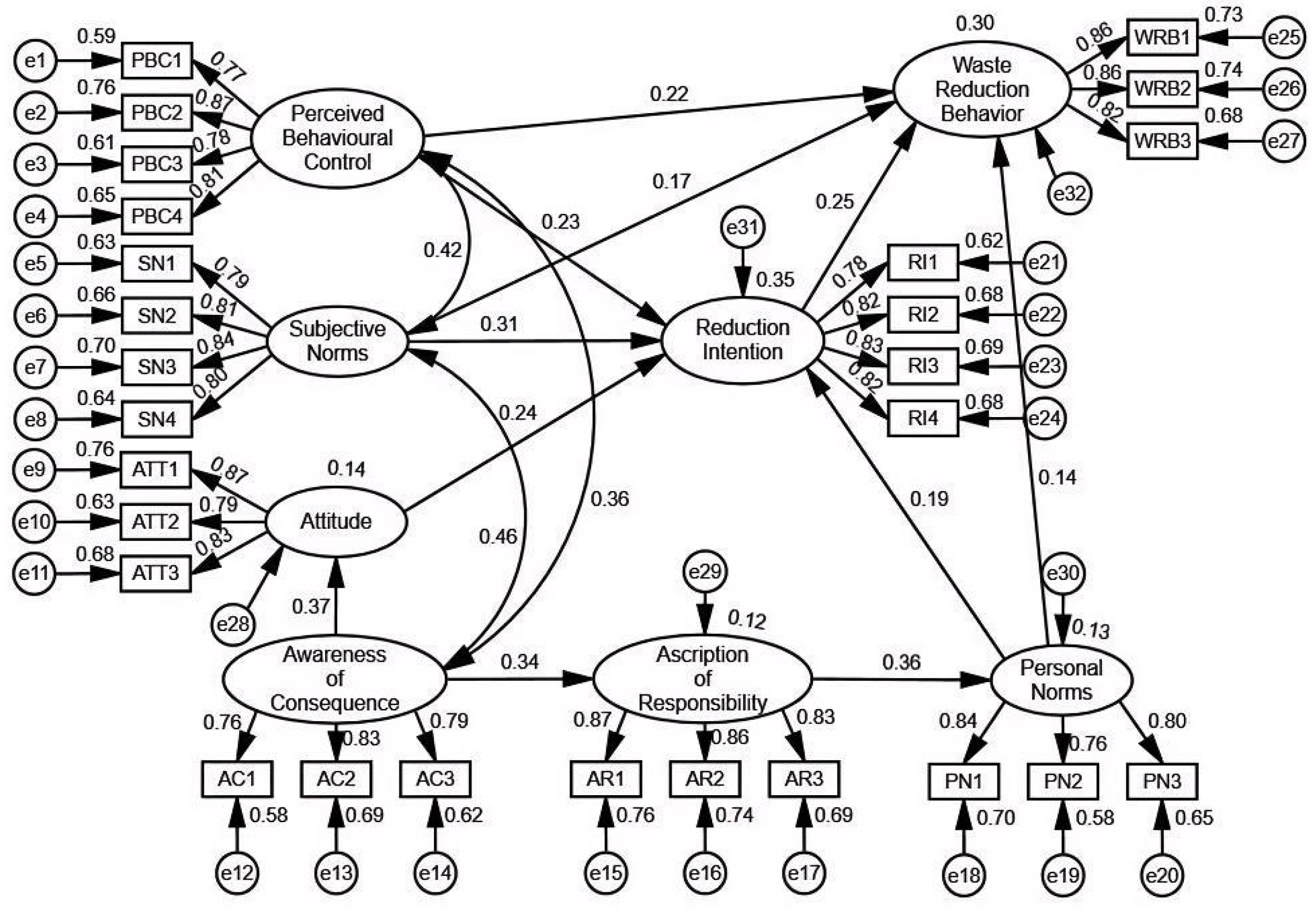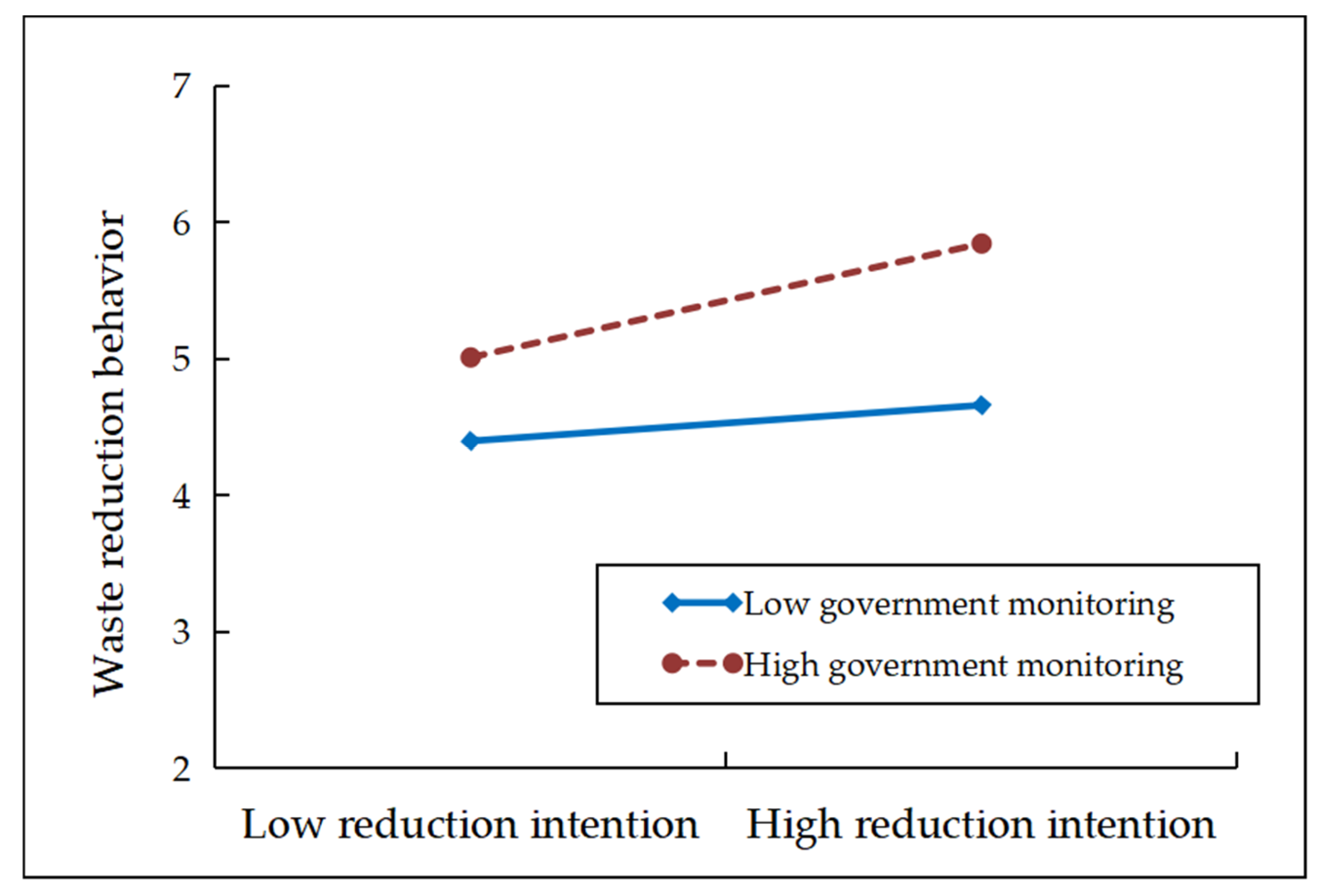1. Introduction
Against the backdrop of new-type urbanization, the large volume and rapid growth of construction waste generation, coupled with low resource recovery rates, have imposed significant environmental and societal burdens [
1]. In response to the growing challenge of construction and demolition waste, zero-waste management has emerged as a systemic strategy for advancing sustainable development and is gaining increasing attention worldwide [
2]. Currently, the construction industry generates a substantial amount of construction waste, leading to a severe manifestation of “garbage siege” [
3]. Digital and industrialized approaches, such as Building Information Modeling (BIM) and prefabrication technologies, are being widely applied in construction waste reduction practices. Bibliometric analyses indicate that these technologies have become a core theme in zero-waste research [
4]. If properly managed, construction waste can be utilized as a resource [
5]. Although approximately 80% of construction and demolition waste has high recycling value [
6], the recycling rate of construction and demolition waste in China is only 5% [
7]. This is considerably lower than the recycling and utilization rates in many developed countries and regions, such as over 90% in South Korea and the European Union [
8], an average of 95% in Japan [
9], and 67% in Australia [
10]. Thus, construction waste generation in the construction industry has become one of the most significant challenges to sustainable development.
This realization has sparked an increasing amount of research to identify the social and psychological processes that underlie waste reduction behavior (WRB) among stakeholders in the construction industry. Li et al. [
11] analyzed that the reason why designers have a positive attitude toward reduction and strong behavioral awareness but take little actual action is that they perceive their behavioral control to be low and lack the constraints of standards, regulations, and policies. In 2020, Yang et al. [
12] used simulation models to pre-evaluate construction waste management policies and strategies for improving waste reduction effectiveness. They were also the first to use system dynamics to investigate the causal relationships underlying the waste reduction behaviors of construction workers. Sun [
13] demonstrated that construction waste reduction (CWR) behavior is significantly influenced by the value views, working conditions, and self-interest of construction workers on the job site, as well as by project authorities’ supervision and management. The role of altruistic motivation in the behavioral decision-making process has been largely overlooked in prior research, even though it has employed classical behavioral theories like the Theory of Planned Behavior (TPB) to examine the fundamental causes of reduction behavior [
12], motivational factors of willingness to reduce behavior [
14], and important determinants of reduction behavior among stakeholders [
15]. TPB has been used in studies in sociology, economics, and environmental studies. The Norm Activation Model (NAM) was developed by Schwartz (1977) [
16] and has been used extensively to characterize and forecast pro-social behavior on an individual basis. It was a significant discovery made by social psychologists studying altruism. It posits that individuals can be motivated to act altruistically through the activation of personal norms (PN). The decision-making behavior of Chinese construction contractors is characterized by an interplay of self-interested and altruistic motives. As market entities, their behaviors are motivated by economic rationality, which prioritizes cost control and profit maximization. This is consistent with the self-interested perspective of the TPB, namely its elements of personal interest and perceived behavioral control (PBC). At the same time, increased government monitoring (GM), industry standards, and societal expectations have increased their environmental obligations. Consequently, altruistic elements like environmental ideals and a sense of social responsibility also have an impact on their behavior with regard to reducing construction waste. This precisely falls within the explanatory domain of the NAM. However, a single theoretical framework struggles to fully elucidate their complex decision-making mechanisms: TPB may underestimate the influence of moral motives, whereas NAM tends to overlook real-world economic constraints. Therefore, an integrated approach incorporating both perspectives is necessary for a more accurate understanding of contractors’ behavioral logic under the dual pressures of economic efficiency and environmental responsibility. In order to provide policymakers and construction companies with a reference for decision-making, this study intends to integrate the TPB and NAM in order to examine the impact of both egoistic and altruistic factors on CWR behavior among Chinese contractors.
This paper’s remaining sections are arranged as follows: A thorough literature assessment is given in
Section 2, and the research hypotheses are described in
Section 3. The study technique is explained in
Section 4, and the findings of the hypothesis testing are presented in
Section 5. The study’s main conclusions are presented in
Section 6, with theoretical and practical implications discussed in
Section 6.1 and
Section 6.2, respectively. In
Section 7, the paper concludes with a summary of key findings and recommendations for future research.
2. Literature Review
Understanding the connection between human factors and construction waste generation is essential for uncovering the key drivers of waste reduction and fostering sustainable practices among stakeholders [
17]. Research shows that various stakeholders encounter multiple challenges in implementing CWR. For example, construction workers generally demonstrate inadequate knowledge of waste reduction due to insufficient education and environmental training, which impedes their capacity to comprehend and apply reduction tactics [
18]. While contractors generally express willingness to minimize waste, their efforts are hindered by obstacles such as an immature market for recycled materials, inadequate recycling technologies, and weak regulatory enforcement [
19]. Similarly, designers responsible for embedding waste reduction into the design process are influenced by issues like frequent design modifications, a lack of integration of waste reduction principles, ambiguous design specifications, insufficient expertise in sustainable design, and unclear accountability for CWR outcomes [
20].
To better understand the psychological mechanisms behind stakeholders’ CWR behaviors, scholars have increasingly applied established behavioral theories, particularly the TPB, which has been widely recognized for its effectiveness in explaining pro-environmental actions, including waste management practices [
21,
22]. This body of research demonstrates that factors such as attitudes, subjective norms, and perceived behavioral control are significant predictors of CWR intentions and behaviors. Nevertheless, relying solely on TPB provides an incomplete account, as contractors’ CWR actions are also shaped by additional factors such as perceived consequences, sense of responsibility, personal norms, and government oversight, indicating gaps in current research.
Government monitoring, along with related policies and regulations, has been shown to exert a significant influence on contractors’ engagement in CWR. The role of government is especially critical in developing countries, where the construction sector plays a central role in economic growth [
23,
24]. To address escalating waste issues and advance sustainability, governments in developing regions have also taken active steps by introducing strategic initiatives to advance CWR in construction [
8,
25,
26,
27]. Yusof et al. (2017) asserted that regulatory requirements are the most powerful incentive for companies to adopt environmental measures, as compliance pressure motivates stakeholders to act [
28,
29]. Ding et al. (2016) emphasized that effective regulations, coupled with monitoring, significantly encourage positive contractor behavior, and that robust legal frameworks with strict oversight can foster the adoption of CWR practices [
30]. Although contractors are primarily profit-driven and may favor economic over environmental priorities when trade-offs arise [
31], government subsidies serve as an effective policy tool, providing positive reinforcement. Economic incentives can steer firms toward CWR strategies, and well-designed subsidy schemes can align corporate behavior with sustainability goals [
32,
33].
From a theoretical standpoint, TPB functions as a rational choice model of environmental behavior [
34], primarily analyzing decisions through a self-interested cost–benefit lens, yet it fails to account for the motivational power of altruistic intentions in pro-environmental actions [
35]. In contrast, the NAM has been widely applied to study various pro-environmental behaviors, which are often viewed as forms of pro-social behavior [
36]. However, a major drawback of NAM is its exclusive focus on moral norms and social responsibility, overlooking the impact of rational and instrumental factors. Although both TPB and NAM offer strong explanatory value for understanding contractors’ CWR behaviors, each emphasizes either self-interest or altruism in isolation, thus falling short in capturing the full complexity of individual psychological processes [
37]. While TPB centers on economic incentives and social influence, NAM focuses on personal environmental values and moral duties. This theoretical dichotomy limits the comprehensiveness of behavioral analysis. Therefore, integrating TPB and NAM is necessary to bridge their theoretical gaps and achieve a more unified understanding. The combined TPB-NAM has already been used to predict pro-environmental behaviors in construction, such as intentions to purchase prefabricated housing, willingness to sort and recycle waste, and on-site recycling of construction and demolition plastic waste [
38,
39,
40]. As standalone models become increasingly inadequate for explaining green behavioral intentions, this study argues that combining TPB and NAM offers complementary theoretical insights, enabling a more thorough investigation of the psychological mechanisms underlying contractors’ CWR behavior.
6. Discussion
SEM results validated the integrated TPB-NAM’s explanatory power, showing that both egoistic and altruistic psychological factors strongly influenced Chinese contractors’ intention to reduce construction waste. The primary theoretical contribution of this integrated framework lies in uncovering complex interrelationships that cannot be fully captured by any single theory. For instance, behavioral intention mediates the translation of personal norms into actual behavior, revealing a distinct pathway through which moral motivation is converted into action within the institutional and operational constraints of China’s construction industry. Contractors’ reduction intention had the greatest influence on construction waste reduction behavior. This is consistent with a study on waste reduction behavior by Ertz et al. (2021) [
60], which found that consumers’ intention to engage in waste reduction behavior increases with their level of awareness and that behavioral intention accounts for about half of the variance in waste reduction behavior. By raising contractors’ awareness of the need for conserving natural resources and reducing waste, their intention to minimize waste can be strengthened during the implementation of construction waste management initiatives. Thus, by receiving the proper instruction and training, contractors can gain the necessary knowledge and abilities to comprehend the environmental risks associated with waste, strengthening their resolve to cut waste while encouraging CWR behavior in the building sector, thus reducing the production of construction waste.
The results show that perceived behavioral control had a large beneficial impact on CWR behavior, which is consistent with the findings of Li et al. (2022) [
21], who showed that contractors are much more likely to apply waste reduction measures if they believe they are feasible. As per the TPB, the intention to undertake a behavior can only be established when perceived behavioral control reaches a certain threshold. Hence, perceived behavioral control significantly influences contractors’ engagement in CWR behavior.
Additionally, the study discovered that personal norms had less of an impact on waste reduction behavior than subjective norms. The stratified governance structure prevalent in the construction sector, together with the collectivistic cultural context of Chinese society, is closely linked to this finding. In China, organizational hierarchies are clearly defined, and contractors’ employees typically comply with directives from managers and clients. Moreover, in the fiercely competitive construction industry, clients often hold a dominant position, creating strong incentives for contractors to meet client-driven environmental requirements. As a result, external normative pressures—such as expectations from managers, clients, and government authorities (i.e., subjective norms)—exert a more direct influence on behavior than internalized moral obligations (i.e., personal norms). This is consistent with research by Li et al. [
15], who discovered that subjective norms significantly surpass personal norms in determining construction workers’ CWR behavior. Ramayah et al. [
41] also noted that social pressure exerts a particularly significant influence on behavior in regions where collectivist culture is prevalent. Furthermore, the recognition of one’s behavioral impacts positively influences the ascription of responsibility and indirectly reinforces personal norms through this pathway. When contractors acknowledge their responsibility for reducing waste, they are more inclined to uphold higher standards and fulfill their obligations during project execution.
The institutional environment plays a crucial role in enabling the conversion of waste reduction intentions into actual CWR behavior, as demonstrated by the examination of the moderating influence of government monitoring. Under high levels of government monitoring, the promoting effect of reduction intention on behavior was significantly stronger than under low monitoring conditions, which contrasts with the finding of Wu et al. [
31] that the absence of government monitoring leads to illegal dumping of construction waste. Effective government monitoring is essential for motivating stakeholders to embrace waste reduction practices [
29]. Therefore, the government should actively establish and enhance regulations and laws regarding construction waste, as well as set up a dedicated monitoring body. Kim et al. [
61] proposed that governmental oversight of environmental practices not only enhances companies’ environmental capabilities but also facilitates their investment in and utilization of innovative technologies. This not only supports a circular economy but also contributes significantly to reducing environmental pollution. Government monitoring positively moderates the transformation of reduction intention into behavior, likely through two potential mechanisms. First, there is legitimacy pressure: when regulations are clear and strictly enforced, waste reduction behaviors become a prerequisite for organizational legitimacy, prompting contractors to institutionalize environmental practices. Second, the mechanism involves the deterrence effect: high penalties or reputational sanctions raise the costs associated with non-compliance, thereby transforming waste reduction from a “moral choice” into a “rational avoidance” of adverse consequences. Future research could differentiate the psychological pathways of “incentive-based” versus “punitive” regulation to provide a more nuanced basis for the optimal combination of policy instruments.
This study not only contributes to the behavioral theory of construction waste reduction but also provides actionable insights for policymakers and industry stakeholders.
6.1. Theoretical Implications
- (1)
Reduction intention, perceived behavioral control, subjective norms, and personal norms were all confirmed to have a significant positive impact on CWR behavior, with reduction intention and perceived behavioral control exhibiting the most prominent effects. This demonstrates that the application of behavior necessitates both external resource assistance and subjective motivational drive. It implies that contractors’ efforts to cut down on construction waste are mostly motivated by self-interest. Meanwhile, awareness of consequences considerably and positively increased ascription of responsibility, and indirectly affected personal norms through this pathway.
- (2)
Reduction intention was strongly positively impacted by subjective norms, attitude, perceived behavioral control, and personal norms; reduction behavior was directly predicted by subjective norms and perceived behavioral control. This illustrates how contractors’ behaviors are heavily reliant on outside restrictions and resource assistance due to the construction industry’s stringent regulations and resource-intensive features. However, personal norms influenced behavior through the mediating role of reduction intention, indicating the importance of translating moral awareness into actual action.
- (3)
Between TPB and NAM, personal norms played a key role in affecting contractors’ willingness to reduce construction waste in China, while greater awareness of consequences could foster more positive attitudes toward waste reduction practices.
- (4)
This study advances the theoretical foundation of the literature regarding construction waste reduction or management. Previous studies have mostly looked at how each variable affects stakeholders’ actions exclusively from a TPB or NAM perspective. In contrast, this study employs an integrated TPB-NAM to evaluate contractors’ CWR behaviors, thereby advancing our understanding of such behaviors.
6.2. Practical Implications
The results of the study can guide the creation of strategies and policies for promoting the reduction in construction waste. The data analysis results show that egoistic factors significantly influence CWR behavior, indicating that contractors should place greater emphasis on tangible benefits such as financial returns, cost control, and resource efficiency in their decision-making. Although altruistic factors have a relatively smaller impact, they still play a non-negligible role in fostering long-term sustainable behavioral patterns. From a practical standpoint, this study offers important implications for decision-makers.
First, the most critical factor in promoting CWR behavior is individuals’ intention to reduce construction waste. Therefore, to enhance such intentions, government agencies, universities, and research centers should develop targeted training programs focused on construction waste minimization strategies. Governmental organizations should strengthen public awareness campaigns about the dangers of construction and demolition waste to encourage sustainable practices in the sector. Such efforts are essential to inform contractors that improper waste management not only leads to environmental degradation and deteriorated air quality but also increases human susceptibility to respiratory diseases [
62]. This would ultimately facilitate the implementation of waste reduction practices by enhancing industry practitioners’ waste reduction intention.
Secondly, contractors’ perceived behavioral control significantly influenced their CWR behavior. To facilitate the adoption of effective waste reduction practices, complementary strategies may include: disseminating proven minimization technologies, enabling organizational shifts in management approaches, providing access to technical support, and implementing incentive-based financing mechanisms to address financial barriers.
Additionally, the subjective norm significantly influenced contractors’ involvement in CWR behavior. To decrease construction waste, it is essential for governments to implement comprehensive, systematic, and actionable guidelines and management regulations that delineate the duties and accountabilities of all parties involved. This would promote the development of unified industry standards. Fostering a societal culture that supports “green construction, resource conservation, and environmental protection” is essential. This would strengthen normative pressures within the industry and enhance public expectations for oversight, thereby promoting waste reduction as a widely accepted industry consensus and mainstream value.
Fourth, individual norms significantly influenced CWR behavior through the full mediating effect of reduction intention, highlighting the crucial role of intrinsic moral responsibility. This result clearly illustrates the theoretical benefit of combining the TPB and the NAM: TPB clarifies how moral norms are translated into action through behavioral intention, especially when faced with practical and contextual constraints, whereas NAM takes into account the activation of moral norms. It is therefore essential for market stakeholders, in the design of incentive mechanisms and industry evaluation frameworks, to promote sustainable development by cultivating environmental values and professional ethics within corporate cultures and embedding them in employee training initiatives. To enable contractors to internalize the necessity and legitimacy of waste reduction practices as stable personal norms, thereby strengthening their intention to reduce waste and translating this intention into actual behavior.
Finally, government monitoring effectively facilitated the translation of the intention to reduce waste into behavior that reduces construction waste. The greater the level of government oversight, the more probable it is that contractors will turn their intentions into concrete actions to reduce waste. The government should enhance regulations, but this would undoubtedly add to its administrative workload. Under these circumstances, offering financial incentives to contractors who take waste reduction actions would boost their initiative in cutting down on construction waste and motivate them to proactively incorporate waste-reduction techniques into their work. As a result, administrative burdens would be reduced and government monitoring would be far more effective. As a result, both the government and contractors will benefit from the combination of strict government monitoring and financial assistance.
The findings of this study carry significant implications for macro-level sustainable development. Effective construction waste reduction behaviors by contractors, as a form of resource conservation and environmentally responsible practice, objectively contribute to reducing dependence on virgin resources and mitigating energy consumption and pollution emissions associated with waste landfilling and transportation. This behavioral shift at the micro level not only provides foundational momentum toward advancing a circular economy in the construction industry but also serves as a critical pathway for achieving Sustainable Development Goal (SDG) 12 on Responsible Consumption and Production. Furthermore, in the context of China’s national strategy to achieve carbon peak and carbon neutrality, promoting waste reduction behaviors among key stakeholders in the construction sector holds profound policy significance for building green and low-carbon urban-rural development models.
7. Conclusions
It is crucial to concentrate on the main elements influencing contractors’ adoption of CWR practices and their decision-making processes to accomplish sustainable development in China’s construction industry and slow down global warming. To begin with, CWR procedures offer significant environmental advantages, including the conservation of resources, protection of the environment, and the advancement of sustainable development, while also serving the personal interests of contractors. In order to develop a research model for analyzing CWR behavior among Chinese contractors while simultaneously taking into consideration both egoistic and altruistic factors, this study combines the TPB with the NAM. Second, SEM was used to examine the data from a survey of 382 Chinese contractors. The findings suggested that contractors’ CWR behavior was influenced by both egoistic and altruistic motivations. It clarified the effects of subjective norms, personal norms, perceived behavioral control, and waste reduction intention on CWR behavior, showing that waste reduction intention had the biggest influence on CWR behavior. Subjective norms, perceived behavioral control, and personal norms were found to directly predict CWR behavior. Subjective norms and perceived behavioral control had the strongest effects, while personal norms only had an impact on behavior through the mediating function of waste reduction intention. Awareness of consequences significantly enhanced ascription of responsibility, which in turn positively influenced personal norms, serving as a mediating mechanism. Consequence awareness also influenced contractors’ attitudes toward CWR. Finally, government monitoring exerted a positive moderating effect on the process of translating waste reduction intention into CWR behavior. A core theoretical contribution of this study lies in its clear revelation, through the integration of TPB and NAM, that personal norms must operate via the mediation of behavioral intention to influence behavior, thereby highlighting the unique advantage of the integrated model in dissecting complex decision-making processes.
Notwithstanding the study’s theoretical and practical significance, there are several shortcomings that call for further development. First, this study focused on contractors’ perceived influencing factors for CWR behavior, not their actual activities. Future research should incorporate actual behavior for a more comprehensive understanding of its drivers. Second, while focusing on Chinese contractors, this study notes that significant internal division of labor (e.g., general, specialized, labor subcontractors) creates systematic differences in capabilities and perceptions regarding CWR. Future research should target specific contractor types to enhance applicability. Lastly, this study used cross-sectional data, limiting causal inference; future work should consider longitudinal data. Furthermore, sample selection may restrict industry-wide generalizability due to regional and project scale differences. Future research should broaden the sample to comprehensively investigate CWR drivers and behaviors across different regions, contractor types, and project kinds, also exploring the impact of the construction waste management supply chain to develop a more systematic and nuanced theoretical framework. Future studies could also examine behavioral driver differences among contractor roles or use dynamic game theory models to analyze long-term policy effects.









